In-flight Rules and Cautions
We ask your cooperation in the following items so that all passengers enjoy a trip on Star Flyer.
- Smoking is prohibited in the cabin.
- Some activities are prohibited by law (inconvenience passengers inside the cabin)
- Use of electric (electronic) devices is restricted.
- We ask passengers in the exit row seats for their cooperation during an emergency evacuation.
- Keep your seatbelt fastened at all times.
- Properly stow carry-on luggage.
- Elderly passengers and passengers with children
- Safety Guide
In-flight Rules
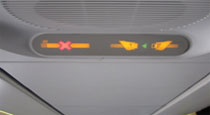
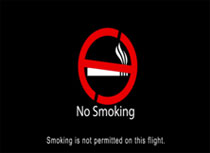
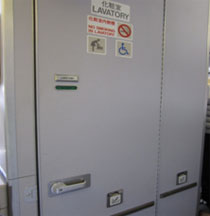
- No smoking in the cabin. (All Japan domestic and international flights)
Use of open flame in the cabin is strictly prohibited as doing so may cause a fire. - Use of e-cigarettes and also other smoking tools that do not use flame in the cabin are strictly prohibited as doing so may cause concern and misunderstanding among other passengers.
- Be careful not to drop lighters.
Lighters that fall out from one’s pockets or are dropped and become wedged between cushions may cause a fire. - Lavatories are equipped with smoke and fire detectors. Smoking in the lavatory is prohibited by law because doing so may lead to a fire or major accident.
Please note that the mandatory ashtrays installed on lavatory doors are to use for putting fire and not for the purpose of smoking. - Smoking in the lavatory and actions to disable function of smoke detectors are punishable by law.
- Alert a cabin attendant if you notice use of open flame, fire or an odor in the cabin.
Acts that Impede Safety (inconvenience passengers inside the cabin)
To keep safe flight, Civil Aeronautics Act has declared the following activities “Safety Impeding Acts” that must not be carried out inside the cabin.
- Acts that impede safety of the aircraft
- Acts that impede safety of passengers and their belongings
- Acts that disrupt order in the cabin
- Acts that violate order in the cabin
The captain may issue a prohibition order for the following actions in particular. A passenger who does not follow the order to cease and desist the act may be fined up to JPY 500,000. Also, the notification to the police, who may be requested to standby; or the passenger may be restrained and actions taken to temporarily land the aircraft at a location other than the destination. (Civil Aeronautics Act Article 150)
Prohibition of Acts that Impede Safety
Acts impeding safety,etc

Smoking in the lavatory

Using restricted electronic devices such as cell phones

Acts that may obstruct the work of cabin attendants, or prevent maintenance of safety

Failing to obey instructions to wear a seatbelt

Refusing to return your seat backs and trays to their original or upright position during takeoff or landing

Placing and refusing to move carry on baggage where it will obstruct emergency evacuation

Actions that involve operating, moving, or impairing the functionality of fire extinguishers, emergency alarm devices, life jackets, etc.

Unauthorized operation of the cabin doors or exits
Restrictions on the use of electronic devices inside the cabin
The use of some electronic devices inside the cabin is restricted, in accordance with a public notice issued by the Ministry of Land, Infrastructure, Transportation and Tourism.
Violators may be fined up to JPY 500,000.
| Types of electronic devices | List of applicable electronic devices | Restriction timeframes |
|---|---|---|
| (1) Electronic devices that emit communications data when turned ON (Devices with an output of 100 milliwatts or less are exempt.) |
|
From the time the main doors of the aircraft are closed in order for the aircraft to take off, until the post-landing taxiing has been completed. (Note 1) |
| (2) Electronic devices that do not emit communications data when turned ON |
The following electronic devices that do not emit communications data (Note 2)
|
May be used at all times |
- (Note 1)
Electronic devices in all states (settings) may be used “until the main doors of the aircraft are closed for takeoff” and ”after the post-landing taxiing has been completed”. The cabin attendant will make an announcement at the time that post-landing taxiing is complete.
- (Note 2)
The status of a device that does not emit communications data refers to: Flight Mode, Offline Mode, etc. (names of these modes differ by manufacturer), sending and receiving calls and email as well as the state in which Internet functions are turned off even if power is on.
- If the captain determines that there is an obstruction to a safe flight, you may be asked to refrain from use even during a period in which your device can be used.
Star Flyer separately restricts use of electronic devices other than those above, and a cabin attendant may alert a passenger of this fact. Thank you for your understanding. (Examples: e-cigarettes, VHF scanners) - Please turn off any electronic device before storing it in any baggage you will check.
- To ensure a safe flight, cabin attendants may check whether an electronic device is in use or its settings. Thank you for your cooperation.
- We ask your cooperation to refrain from use of electronic devices when you are seated near a passenger with a pacemaker or using a medical device.
- Please refrain from talking on the cell phones inside the cabin as it may disturb other passengers.
Passengers with cell phone services for children
Some cell phone services for children from NTT Docomo, au and SoftBank may periodically turn on and transmit data automatically even while the cell phone itself is turned off if Power Off Alerts are turned on in Settings.
For in-flight safety reasons, use of electric (electronic) devices is prohibited.
We ask passengers with the following models to either completely turn off cell phones or ensure that Power Off Alerts are turned OFF before boarding.
- Passengers with an NTT Docomo Kids’ Keitai™ SA800i click here
- Passengers with an NTT Docomo Kids’ Keitai™ F801i click here
- Passengers with an au Junior Keitai A5520SAII click here
- Passengers with an au Junior Keitai A5525SA, Sweets cute click here
- Passengers with an au Junior Keitai K001 click here
- Passengers with an au Junior Keitai mamorino/mamorino2 click here
- Passengers with an au Junior Keitai mamorino3 click here
- Passengers with SoftBank Kodomo Mobile 812T click here
Request to passengers assigned to an exit row seat
In accordance with a directive issued by the Japanese Ministry of Land, Infrastructure, Transport and Tourism, from April 1, 2009, for the safety of all passengers, exit row seats will be limited to passengers that satisfy all the conditions below.
- 1
Aged 15 years old or over
- 2
Does not require the assistance of an escort or staff
- 3
Is capable of assisting in an emergency evacuation, such as opening or closing an aircraft door
- 4
Can understand evacuation procedures and crew’s instructions, and verbally convey such information to other passengers
- 5
Can speak Japanese or English
- 6
Does not have to assist an accompanying passenger in an emergency evacuation
- 7
Does not accompany children (7 years old or under)
- 8
Consents to providing assistance in an emergency evacuation
Passengers seated in exit row seats will be requested to assist during an emergency evacuation under instructions of cabin attendant. Passengers who do not meet the above requirements will be asked to move to other seats.
Assistance in an Emergency Evacuation
- Keep other passengers away from the exit until the crew member securely opens it.
- Follow the crew member’s instructions. Open the exit after they have confirmed the safety outside the aircraft.
- After the escape slide fully inflates, have other passengers evacuate as quickly as possible.
- Stand next to the escape slide, pull up others coming down the escape slide to evacuate.
- Direct other passengers to move away from the aircraft immediately.
- Other (crew members will instruct other tasks when it is necessary.)
- *
Please read the in-flight safety instructions leaflet provided promptly after you board.
- *
Those who are unable to perform or who do not wish to perform the tasks listed above are unable to sit at the exit row seats. Thank you for your understandings.
Evacuation Rules
Precautions for Evacuation
- Leave all baggage behind when you evacuate.
Baggage could cause an obstruction in the event of an evacuation, or damage the escape slide and render it unusable. - Remove your high-heeled shoes when you evacuate.
High-heeled shoes could damage the escape slide and render it unusable. - Photography is prohibited.
It will delay your own evacuation and obstruct that of others.
Points to note when you slide down

- Keep both legs straight both arms extended forward so that they are parallel to the slide. Upper body upright so that you can see where you land and slide down the slide.
- After sliding down the slide, leave the aircraft as soon as possible.
Assistance

- When assisting other passengers, stand next to the escape slide, pull up others coming down the escape slide to evacuate.
- Call for other passengers to move far away from the aircraft as soon as possible.
Keep your seatbelt fastened at all times.
For your safety, keep your seatbelt fastened at all times.
| During takeoff or landing | Fasten your seatbelt securely at the hipbone so that there is no slack. |
|---|---|
| During flight | Keep your seatbelt fastened at all times even when the Fasten Seatbelts sign is off, in case of sudden, unexpected turbulence. |
| Taxiing before and after takeoff and landing | Stay seated until the Fasten Seatbelts sign is off. Cabin attendants will check that all passengers are seated and seatbelts are fastened before departure. In case of an unforeseen circumstance, the emergency brake may be deployed or an emergency stop made. The aircraft may also temporarily stop and start moving again. |
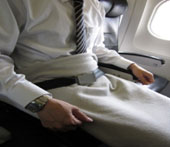
- When using a blanket, please fasten your seatbelt on top of the blanket so that the cabin attendant can check that your seatbelt is fastened.
- Extension seatbelts are available in the cabin. Please inform a cabin attendant if you wish to receive an extension seatbelt.
- For your safety, the cabin attendant may check whether your seatbelt is fastened. Thank you for your cooperation in ensuring the safety of all our passengers.
In-flight stowage
Proper way to stow carry-on baggage
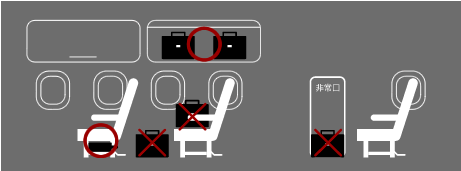
|
|
|
|
|---|
Passengers in first-row seats should use the overhead compartment.
When using the overhead compartment, stow baggage carefully, without stacking or cramming too much baggage in a space.
The baggage inside may shift when the compartment is opened and present a risk.
Do not take any baggage with you in an emergency evacuation.
Elderly passengers and passengers with children
To avoid unforeseen injury, please be aware of the many kinds of equipment and conditions of the aircraft.
Step at main doors
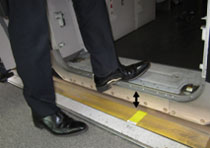
The pathway descends gradually from the boarding gate to the aircraft.
Please be aware that there is a slight difference in height at the main doors to the aircraft, and watch your step when getting on and off the aircraft.
Seat equipment
Seats are equipped with items including a foldup tray table, cup holder, armrests and remote controls.
Be careful to avoid pinching your fingers when using these items.
There are also wiring and fixtures in the seat area.
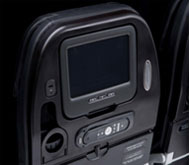
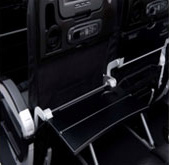
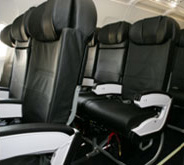
Hot beverages
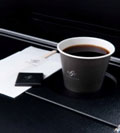
Unexpected turbulence may cause hot beverages to be spilled in the cabin.
Be very careful as such an event may cause burns.
Please notify a cabin attendant if a drink has spilled.
If you are having trouble for any reason, please do not hesitate to call on a cabin attendant for assistance.
Safety instructions
A safety instructions leaflet is available in the seat pocket in front of your for your convenience.
- ~24MC (Front cover) Safety instructions (latest version)(2.71MB)
- ~24MC (Back cover) Safety instructions (latest version)(1.89MB)
- 25MC~27MC (Front cover) Safety instructions (latest version)(2.71MB)
- 25MC~27MC (Back cover) Safety instructions (latest version)(1.89MB)
- 28MC~ (Front cover) Safety instructions (latest version)(2.71MB)
- 28MC~ (Back cover) Safety instructions (latest version)(1.88MB)
- 28MC~ (Front cover) Safety instructions for Turbulence (latest version)(0.62MB)
- 28MC~ (Back cover) Safety instructions for Turbulence (latest version)(0.59MB)




